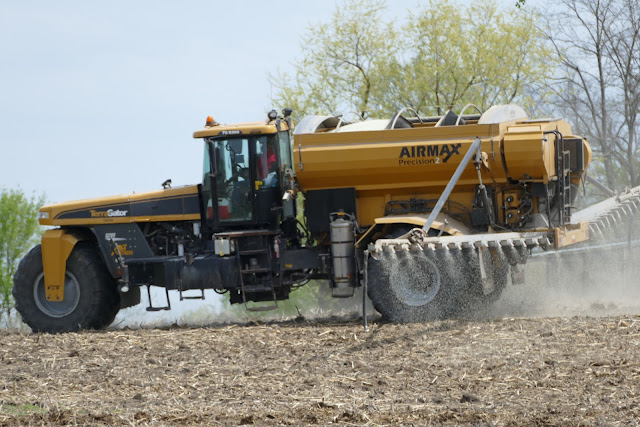Phosphorus fertilizer application only needed every other year in corn-soy rotation

February 3, 2020
[NOTE: UMN Extension nutrient management specialist Dan Kaiser wrote a follow-up to this post relevant to those with high pH (8.0 or greater) soils.]
In pursuit of maximum yields in two-year corn-soy rotations, some farmers are now applying phosphorus (P) fertilizer every year. A 10-year study by University of Minnesota scientists that ended in 2018 says that practice is likely unnecessary. Instead, farmers only need to apply P fertilizer the fall or spring before corn in order to maximize yields for both crops.
The study found that applying P fertilizers, like MAP or DAP, the fall or spring before planting soybeans does not increase soybean yield. As long as enough P fertilizer was applied before the previous corn crop to account for the needs of both corn and soybean, soybean yield was maximized. For corn, results showed a four to five bushel average yield advantage when some or all of the P fertilizer was applied the fall or spring before the crop. This means that farmers could save money on application costs by only applying before corn, instead of before both corn and soybean crops.
Field trials were located near St. Charles, Lamberton, and Morris, Minnesota on soils testing Low to Medium for phosphorus. The study was funded by Minnesota’s Agricultural Fertilizer Research and Education Council (AFREC) and the Minnesota Soybean Research and Promotion Council and is available on the AFREC website.
Applying P to high calcium soils
Previous research has shown that it does not matter whether P is applied in the fall or spring ahead of corn. However, new research on high calcium soils in central and western Minnesota indicates that spring application may have an advantage. Calcium in the soil can bind to the phosphate in phosphorus fertilizer, forming calcium phosphate, which is less available to the crop during early growth.
Preliminary results from the 2019 growing season for an ongoing University of Minnesota study funded by AFREC indicated that spring P application resulted in an average 7% greater corn yield than the same amount of fertilizer applied in fall at two of the three corn locations. The two sites were located near Lamberton and Morris.
Soybean yield was increased by P fertilizer at two of the three locations (Morris and Stewart) but there was no yield difference between fall and spring application.
The trials were conducted on fields with high pH soils, except for the Lamberton site, where surface soils were acidic with a pH near five.
“We are finding more soils with surface soil pH values near or below five across the state,” said Dan Kaiser, University of Minnesota Extension nutrient management specialist and lead researcher on the project. “As soils become more acidic, metals become more soluble and can combine with phosphorus in the soil, similar to what happens with calcium.”
The responsive sites tested low in P and 60 lbs. of P fertilizer maximized either corn or soybean yield at all locations.
“The data is intriguing, but since we only conducted research at three corn locations, more data is needed to determine if farmers should consider spring application of P,” Kaiser said. “And this is just the first year of the study, so I think we need to research this further before changing our recommendations.”
Spring application of P may have provided the crop with a starter effect in the study. If growers are concerned about P fertilizer applied in the fall not being available for early corn growth, Kaiser says they could consider utilizing a liquid starter containing P (like 10-34-0). Previous research has shown that a low rate of P applied in-furrow can help maximize corn yield on soils testing Medium or higher for phosphorus.
By: Paul McDivitt, UMN Extension communications specialist
